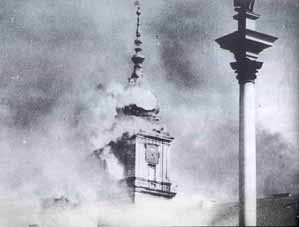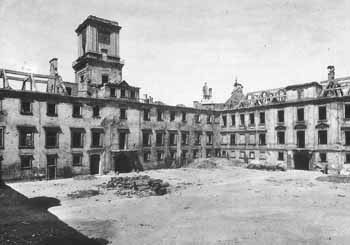
Warsaw's Royal Castle
and its destruction during the Second World War
|
|
Already in the opening days of the German September 1939 invasion, the Zamek had been bombed and set on fire. The ancient structure was not equipped with a fire suppression system and the fire proved difficult to contain. It was eventually brought under control with the aid of the city's general population, summoned through radio appeals, but only after the west wing had been destroyed. In the days that followed efforts were made to remove and hide the many artworks that graced the Zamek. Fearful of the Zamek's fate, the Zamek's staff also removed sections of decorative panels, wall coverings, etc., all that might prove helpful in future reconstruction efforts.
|
|
After the war, a massive program of debris removal and rebuilding was undertaken. A large hole in the ground marked the place where the Zamek had stood, It remained thus till 1971, the task of recreating the ancient structure seemingly an impossibly daunting task. But then the decision was made to restore this symbol of national sovereignty. A national campaign was initiated to collect funds through donations that would make the reconstruction possible and to collect any and all photographs, drawings, etc. that might help in the rebuilding and restoration. The effort took years but eventually in 1988, the restored Zamek, a source of great pride, could again be visited.
Sharp eyed visitors to the Zamek can spot, among the wall coverings, decorative panels, etc, small sections that are just slightly more tarnished or darker in color. These are the entities that were removed from the Zamek's wall's in 1939 and bear witness, in the manner in which they have been matched, to the masterful work of Polish restorers.
|
|
| Info-Poland a clearinghouse of information about Poland, Polish Universities, Polish Studies, etc. |


